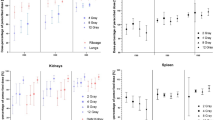Purpose:
A retrospective analysis was conducted on the outcome of total-body irradiation (TBI) followed by bone marrow transplantation (BMT) on leukemia patients. Also studied was the risk of renal dysfunction after TBI/BMT with or without the use of selective renal shielding blocks.
Patients and Methods:
The cases of 109 leukemia patients who received TBI as a component of the conditioning regimen for their BMT were reviewed. They received 12 Gy of TBI in six fractions over 3 consecutive days. Doses to eyes and lungs were reduced to 7 Gy and 8 Gy, respectively, by customized organ shielding blocks. After March 1999, renal shielding blocks were used to constrain the renal dose to 10 Gy. The patients were followed for a median period of 16.6 months (range: 0.3–180.1 months).
Results:
The 2-year and 5-year overall survival rates were 55.4% and 43.2%, respectively. Renal dysfunction-free rates were different between those with and without renal shielding blocks: 100% and 78.5%, respectively, at 2 years. Overall survivals were not significantly different among these patients: 60.4% and 52.9%, respectively, at 2 years in patients with and without renal shielding blocks (p = 0.53).
Conclusion:
The use of selective renal shielding blocks provided evidence for reducing radiation-induced renal toxicities without decreasing the overall survival rate.
Ziel:
Retrospektive Analyse des Outcome der Ganzkörperbestrahlung („total body irradiation“: TBI) vor Knochenmarktransplantation (KMT) bei Leukämiepatienten. Untersucht wurde auch das Risiko von Nierenfunktionsstörungen nach TBI/KMT mit oder ohne Einsatz selektiver Abschirmung der Nieren.
Patienten und Methodik:
Ausgewertet wurden 109 Leukämiepatienten, die eine TBI im Rahmen der Vorbereitung ihrer KMT erhalten hatten. Sie erhielten eine TBI von 12 Gy in 6 Fraktionen an 3 aufeinanderfolgenden Tagen. Die Bestrahlungsdosen an Augen und Lunge wurden durch individuelle Abschirmung auf 7 bzw. 8 Gy reduziert. Ab März 1999 wurden auch die Nieren abgeschirmt, um die Strahlendosis auf 10 Gy zu vermindern. Die Patienten wurden im Median 16,6 Monate (Bereich: 0,3–180,1 Monate) nachbeobachtet.
Ergebnisse:
Die 2- and 5-Jahres-Gesamtüberlebensraten betrugen 55,4% bzw. 43,2%. Der Anteil der Patienten ohne Nierenfunktionsstörung lag in den Gruppen mit oder ohne Nierenabschirmung bei 100% bzw. 78,5% nach 2 Jahren. Beim Gesamtüberleben wurden mit 60,4% bzw. 52,9% nach zwei Jahren keine signifikanten Unterschiede zwischen den Gruppen mit und ohne Nierenabschirmung festgestellt (p = 0,53).
Schlussfolgerung:
Die selektive Abschirmung der Nieren verminderte strahleninduzierte Nierenschädigungen, ohne die Gesamtüberlebensrate zu beeinträchtigen.
Similar content being viewed by others
Author information
Authors and Affiliations
Corresponding author
Rights and permissions
About this article
Cite this article
Igaki, H., Karasawa, K., Sakamaki, H. et al. Renal Dysfunction after Total-Body Irradiation. Strahlenther Onkol 181, 704–708 (2005). https://doi.org/10.1007/s00066-005-1405-8
Received:
Revised:
Issue Date:
DOI: https://doi.org/10.1007/s00066-005-1405-8




